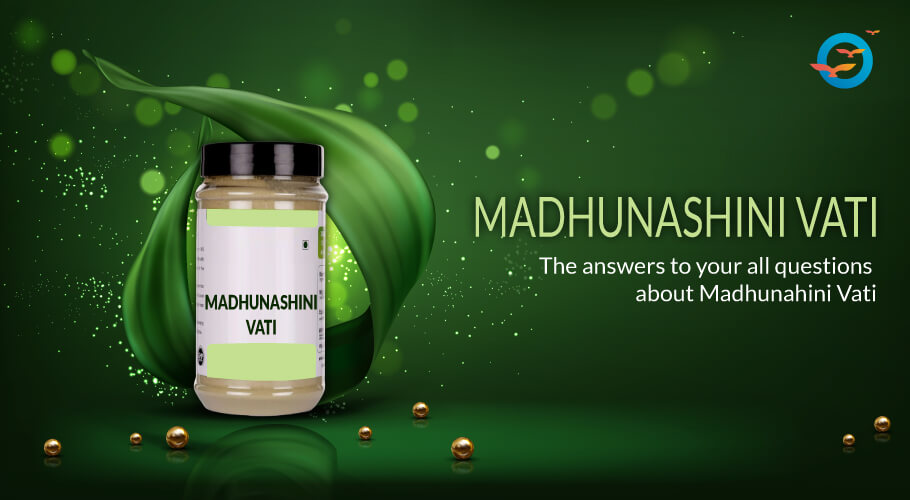Madhunashini Vati for Diabetes

Since Madhunashini is most commonly prescribed as an anti-diabetes treatment, it is necessary to first understand more about the disorder.
What is Diabetes?
The most known characteristic of diabetes is high blood sugar level (BSL) is actually the symptom of another more insidious health risk—insulin resistance. Insulin, which is produced in the body’s pancreas, has one primary function—to allow glucose absorbed from the food we eat to enter muscle cells where it is used to create energy. If left untreated, high BSL damages almost every organ in the body from the eyes to the feet, and leads to a multitude of health complications, including high BP, high cholesterol, kidney disease, heart damage, and even cancer. Here are the -10 comorbidities of diabetes
For a long, long time, the mainstream medical establishment insisted that diabetes was incurable, for life, and irreversible. Now we know different. Freedom from Diabetes itself has more than 12,000 documented diabetes reversal success stories, and programs have helped tens of thousands more across the world get better control of their BSL, get free of medicines, and live happy healthy lives.
The combination of the expense of allopathic drugs, the ever-increasing risk of complications, and the lack of clear resolution of the disorder has led many diabetics to explore traditional healing therapies, of which, Ayurveda is the most popular, and Madhunashini is one of its best-known medications.
What is Madhunashini?
- Madhunashini is a proprietary ayurvedic preparation used to treat diabetes.
- It is said to improve blood glucose management and help in preventing diabetic complications that occur due to the effect of high blood glucose levels on the body’s organs.
Some of the benefits Madhunashini is said to offer, include:
- Improve overall health
- Improves overall functioning of the body’s organs
- Protect nerves, heart, eyes, blood vessels, and kidneys from the effect of high BSL
What is Madhunashini made from?
The medication comprises the following ingredients:
Aqueous Extracts:
- Neem – Azadirachta indica
- Gurmar – Gymnema sylvestre
- Chirayata – Swertia chirata
- Saparangi – Salacia Chinensis
- Gokshura – Tribulus terrestris
- Bilva (Bael) – Aegle marmelos
- Kutaja – Holarrhena antidysenterica
- Ashwagandha – Withania Somnifera
- Amalaki (Amla) – Emblica Officinalis
- Kachur (zedoary) – Curcuma zedoaria
- Bibhitaki (Bahera) – Terminalia bellirica
- Bargad (Indian banyan) – Ficus benghalensis
- Giloy (Indian Tinospora) – Tinospora cordifolia
- Haritaki (Harar) Chhoti – Terminalia chebula
Powdered Herbs:
- Kutki – Picrorhiza kurroa
- Vasaka – Adhatoda vasica
- Babul (Kikar) – Acacia arabica
- Haldi (Turmeric) – Curcuma longa
- Jamun (Java Plum) – Syzygium cumini
- Shuddha Kuchla – Strychnos nux-vomica
- Methi (Fenugreek) – Trigonella foenum-graecum
- Kali Jeeri (Kalijiri) – Centratherum anthelminticum
Added Excipients (stabilizing component that complements the active ingredients)
- M.C.C.
- Talcum
- Aerosil
- Gum Acacia
- Magnesium Stearate
Can Madhunashini be made at home?
Yes, indeed; one can prepare Madhunashini at home, using the above-mentioned ingredients. Proportions should be obtained from a qualified Ayurvedic practitioner.
Method:
- Clean all the ingredients to remove dirt and other impurities
- Dry them totally under direct sunlight. There should be no moisture
- Soak the plant parts and dry till the mixture turns powdery
- Mix all the aqueous components together and add the powdered herbs to it
- Add the excipients one after the other.
- Dry this coarse mixture in direct sunlight. This will remove moisture and turn the mix powdery.
- Rolls little portions of the powder between your palms to make small circular balls or vatis utilizing the powder
- Store these balls (vatis) in a glass container and keep the container in a cool, dry place for future use.
How does Madhunashini help diabetics?
The Ayurvedic name for diabetes is known as Madhumeha, and Nash Karna means to destroy. So Madhunashini can be literally translated as diabetes destroyer.
The presence of several beneficial herbs makes it an outstanding formulation for diabetes care. From an Ayurvedic point of view, it can be said to improve the metabolism because three primary reasons:
- Its Tikta (bitterness)
- Its Kashaya (astringency)
- Its ability to balance the Kapha-Pitta doshas.
1. It is believed that the formulation has an exceptionally anti-glycemic nature, which plays a key role in reducing blood sugar levels.
2. This herbal medicine is said to improve the functioning of the pancreas, which, in turn, balances the secretion of insulin.
3. In addition, it is said to regulate the metabolism of carbohydrates, which controls the quantity of glucose circulating in the blood and its conversion into glycogen. This avoids sudden spikes in blood glucose levels, enabling patients to exert natural control over their blood sugar levels.
What are the other health benefits of Madhunashini Vati?
1. Promotes Weight loss
Madhunashini is rich in alkaloids and flavonoids. These are potent anti-oxidation and anti-inflammatory agents. Inflammation in the body is one of the key triggers of insulin resistance, these micronutrients reduce inflammation, helping balance blood sugar levels.
It also suppresses unnatural hunger cravings, helps reduce weight, and avoids obesity. The formulation is said to help evacuate Ama from the body. As per Ayurveda, Ama is a harmful substance that must be removed from the body completely. If allowed to accumulate, it is said to block the flow of energy and cause a build-up of toxins which are the underlying cause of all diseases.
- Lowers LDL Cholesterol
- Quells hunger pangs; eliminates overheating
- So using Madhunashini regularly is believed to remove toxins from the body
Madhunashini is purported to lower LDL (Bad Cholesterol) levels in the body, which in turn, improves metabolism and avoids complications like heart disease and stroke.
2. Dissipates Stress and Anxiety
- Stress is one of the key causes of insulin resistance. A byproduct of urban living, stress often goes unnoticed and untreated. But its presence causes inflammation, which progresses to insulin resistance, and is also known to aggravate existing diabetic conditions by unbalancing hormone production.
- Madhunashini is said to have natural stress-relieving properties and is said to be able to clear off brain toxins and improve cognitive abilities such as memory, and concentration.
- Its ability to balance doshas in the body is said to be instrumental in improving stress management.
- The vatis (balls/pills) are prescribed to regulate serotonin hormone and reduce various signs of anxiety, like restlessness, uneasiness, cold feet, clammy hands, etc.
3. Reduces Diabetic Retinopathy
Diabetic retinopathy is a common symptom of long-term high blood sugar. It is caused by damage to the tiny blood vessels within the retina, which hinders vision.
Madhunashini is believed to be able to:
- Strengthen blood vessels
- Improve blood circulation
- Protect nerve cells in the retina
- Arrest creation of new blood vessels in the eye
4. Promotes Digestion
Madhunashini is commonly used as a digestive concoction. It is believed to be able to reduce the formation of gas in the alimentary canal, thus, preventing flatulence, bloating, and abdominal distension.
Regular use of Madhunashini is said to:
- Lower indigestion
- Improve appetite
- Enhance absorption of nutrients
- Preventing intestinal infections, by virtue of its anti-inflammatory and anti-oxidative micronutrients.
5. Improves Neural Functions
Madhunashini contains potent antioxidants that can:
- Bring Alertness
- Induce Calmness
- Improve Memory
- Improve Concentration
- Enhance Cognitive function
It is also said to help in treating neurodegenerative disorders, such as numbness of hands and feet, and can fortify and improve the overall functioning of the nervous system
6. Slows Down Ageing
Madhunashini is said to contain several herbs that induce regenerative actions, which slow down the aging process. These include:
- Antioxidant activity
- Tissue repair and regeneration
- Protection against cellular damage
7. Purifies Blood
Madhunashini is believed to be extremely beneficial in purifying blood. It has several detoxifying properties that help in cleansing the blood, improving circulation, and removing toxins from the bloodstream and various organs.
8. Protects against Infections
Madhunashini contains various biochemical compounds that give it powerful anti-viral, anti-bacterial, and antifungal properties. It is said to be effective in eliminating bacteria or germs, which is why it is commonly used to treat wounds. Its bio-active components also help in lowering general debility, weakness, and fatigue, and improving the vitality of the body.
Madhunashini is often used to treat various types of ulcers, including ulcerative colitis, peptic ulcer, canker sores or mouth ulcers, etc. Its bioactive compounds help to
- Treat scar tissue.
- Speed up wound healing
- Promote tissue regeneration
9. Manages Blood Pressure
Madhunashini Vati ingredients make it a natural antihypertensive agent, i.e. it can help normalize blood pressure levels and improve cardiac function.
What is the dosage for Madhunashini Vati?
Dosages for Madhunashini Vati differ from individual to individual, as it depends on several parameters, such as:
- Age
- Appetite
- Muscular strength
- The severity of the condition being treated
It is necessary to consult a well-qualified ayurvedic practitioner and follow their prescription. Standard doses for adults are 1 or 2 tablets, twice a day. The vatis ought to be consumed one hour before breakfast and dinner with water.
Does Madhunashini Vati have any side effects?
Madhunashini Vati has been deemed safe to be consumed. Nevertheless, it is important to consult a qualified Ayurvedic doctor, especially if one is already on other drugs for diabetes. This is because it can cause a sudden and drastic drop in blood sugar, i.e. hypoglycemia. This is a potentially life-threatening situation.
Please note that there are no formal studies of the effect of this medication on pregnant women and breastfeeding mothers.
FAQs
1. What is Madhunashini Vati?
Madhunashini vati is a proprietary ayurvedic preparation used to help manage your diabetes. It contains a blend of herbs and natural ingredients traditionally believed to support blood sugar control.
2. Is madhunashini vati good for diabetes?
Yes! Madhunashini Vati is considered good for diabetes management. Its is an Ayurvedic preperation. It Support better glucose control and improve your insulin sensitivity, making it a useful addition to a diabetes care regimen.
3. How does Madhunashini Vati help with diabetes?
The presence of several beneficial herbs makes it an outstanding formulation for diabetes care. From an Ayurvedic point of view, it can be said to improve the metabolism due to ,Its Tikta (bitterness), Its Kashaya (astringency) andIts ability to balance the Kapha-Pitta doshas.
4. What are the main ingredients in Madhunashini Vati?
It contains aqueous extracts, powdered herbs, and added excipients.
5. What is the recommended dosage of Madhunashini Vati for diabetes?
Dosages for Madhunashini Vati differ from individual to individual. It is necessary to consult a well-qualified ayurvedic practitioner and follow their prescription. Standard doses for adults are 1 or 2 tablets, twice a day. The vatis ought to be consumed one hour before breakfast and dinner with water.
6. Are there any side effects of taking Madhunashini Vati?
Madhunashini Vati has been deemed safe to be consumed. It is important to consult a qualified Ayurvedic doctor, especially if one is already on other drugs for diabetes.
Disclaimer
The contents of this article are intended for informative purposes only. We make no claims about the product in any way. Before making any change to your diet or adding any medication, it is recommended that you consult a qualified medical professional.

